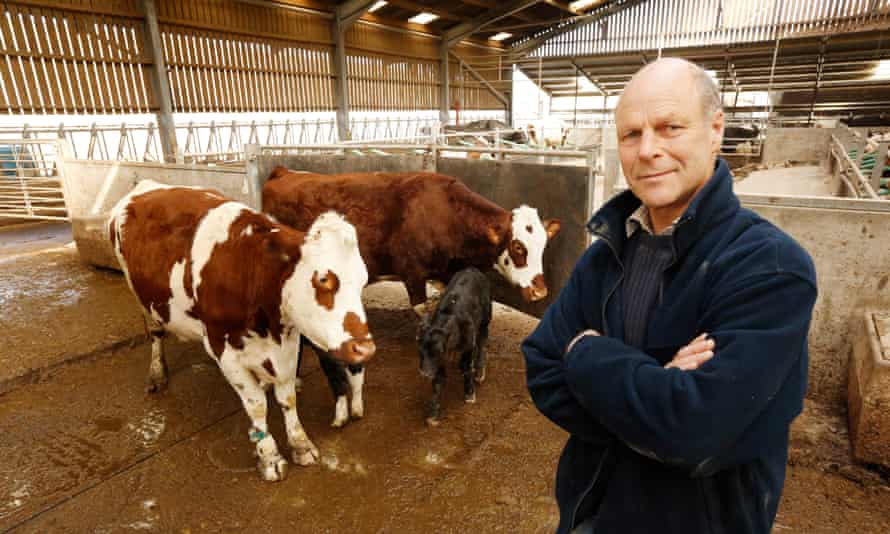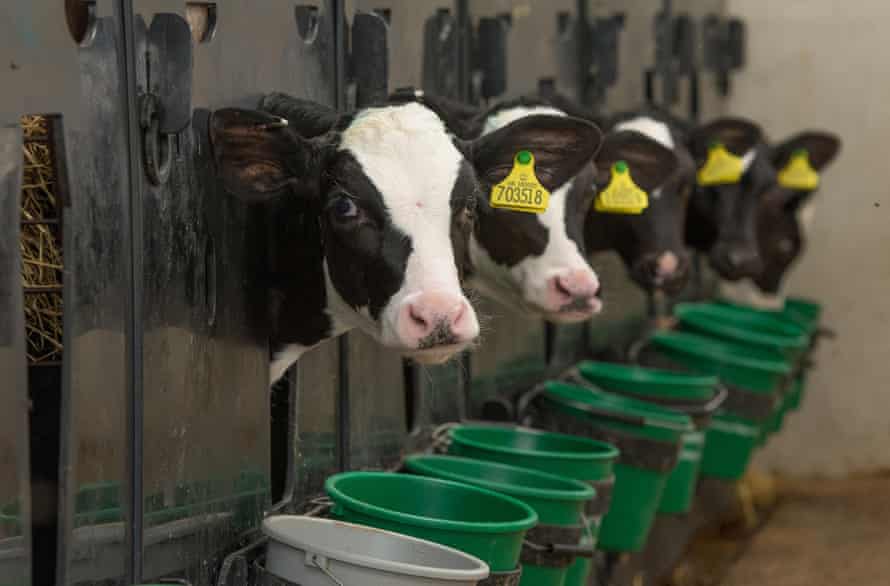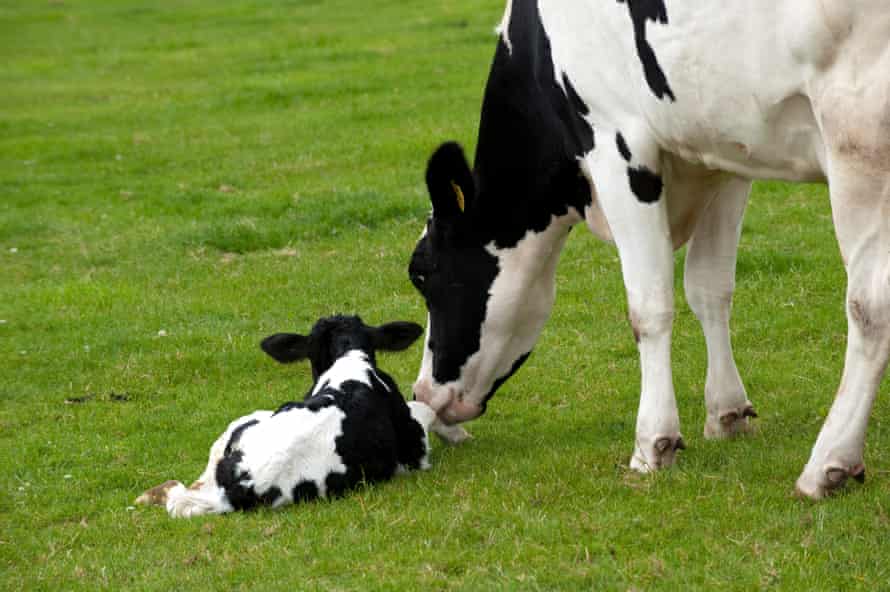You Tube Cow Crying When Baby Is Taken Away
A field of cows with suckling calves may sound similar a normal rural scene. In fact, the view at David Finlay'due south farm on the Dumfries and Galloway coast is a sight you'd be unlikely to see on whatsoever other dairy farm in the UK.
Almost all calves are separated from cows within hours or days of birth on dairy farms. This allows farmers to sell the milk that the calves would otherwise drink.
But it is a reality of dairy farming that jars with beast welfare campaigners and consumers, and 1 of the sector's three biggest emotive bug, along with giving cows outdoor access and the killing of male calves directly after birth.
"It's the one thing nosotros've e'er been asked about by mums on our subcontract tours," says Finlay. "They just don't like seeing calves separated from their mothers so shortly."
The public reaction has led to a slow growth of a new sector, calling itself "upstanding dairy farming", where the calves are not removed immediately from their mothers. One expert estimates that around 400 dairy farms in Europe and Australia are trialling methods – varying widely from one farm to the next – for what is known as "calf at foot" systems.
With a herd of 125 cows, Finlay'southward farm near Castle Douglas in south-west Scotland is the largest known producer in Europe to introduce the calf at human foot arrangement. But the switch, now in its tertiary year, has been far from easy.
Finlay began the project in 2017 with the promise of proving such a method could piece of work at a bigger calibration. "The first yr was disastrous," he says, admitting that he wanted to call it quits. "Nosotros simply couldn't get the cows abroad from the calves and into the milking parlour. For weeks nosotros'd exist dragging the cows in there.

"It took a long fourth dimension for them to trust that the calves were still going to exist in that location when they came back. It was then much stress as the cows just weren't used to information technology and didn't know what the rules were."
Finlay had to be talked into keeping the arrangement going for another year by his family unit and other staff subsequently his herdsman grew sceptical nearly the project and left, simply by the 2nd year the cows had begun to abound used to having their offspring around.
The calves still need to be separated after weaning at effectually v months, a procedure Finlay and his new herdsman Charles Ellett accept learned to manage by starting off with overnight periods of separation first.
"That start day we don't open up the gates in the morning though at that place is a huge outcry from the calves and cows," says Finlay, who has got round information technology by introducing a surrogate female parent – usually an older cow not producing much milk. They then employ this moo-cow to pb all the calves into a field on the other side of the farm to settle them.
The initial menstruation of overnight separation helps create social bonds between the calves, says Finlay, making the final separation easier. The female calves volition and so stay on the farm to become milking cows, while the male calves are sold later on five to 7 months to produce veal.
Leaving calves with their mothers has been establish to reduce bloodshed rates and aid them grow quicker past having all-day access to their female parent'south milk, rather than a milk powder substitute. The suckling can also help protect cows against mastitis, i of the biggest disease risks facing dairy farming today.
However, the suckling adds up to "crazy amounts of milk" lost to the farmer to sell, says Finlay. He estimates his losses at more than ii,000 litres per cow being taken by the calf, which equates to upwards of £500 in lost acquirement based on the electric current U.k. average milk price. The cows too concord back fat for their calves when taken into the milking parlour, "giving united states of america semi-skimmed milk", jokes Finlay.

But Finlay believes the model tin piece of work and that the improvement in the health and immune systems of the immature calves volition yield long-term dividends that will compensate, to some extent, for loss of milk. And he has already seen a surge in interest in what he is doing from across the UK and overseas.
Concluding twelvemonth he raised more £l,000 through a crowdfunding entrada to support the subcontract and its cheese production facilities. Conversely, vegan activism has too helped, he says.
"At that place was no need for it before, but vegan campaigners have raised sensation [among consumers of higher animal welfare] and created a market for united states to supply dairy to. Found-based milks have likewise got people used to paying more for dairy," he says.
It is the loss in milk more than than anything else that Finlay thinks will put off all but a niche group of dairy farmers from always because information technology unless they tin secure a premium for the leftover milk. Still, he is hopeful that consumer back up for more ethical farming approaches volition exist additional by activism.
But other dairy farmers remain sceptical of the health and welfare benefits for the cows and calves – also as the economic science of making it viable. "It'due south simply ethical if you don't know what the downsides are," says National Farmers' Union dairy board member Phil Latham, who runs a dairy subcontract in Cheshire and separates his calves at i week.
"Yes, the calves get to spend more time with their mother, only there are a whole host of compromises with an increment in affliction adventure from the mixing of different age groups and a lack of control over the dogie's food intake. The longer you lot leave the calf on the cow, the bigger the stress when yous do separate them.
"It's pandering to urban ignorance. If he can get a market premium from doing information technology and survive the milk losses and so expert luck to him, simply information technology's non about maximising welfare in my mind," he says.

Bookish researchers say early separation within 24 hours has been found in some cases to reduce distress for both beefiness and dairy cows and calves, although the evidence for dairy calves is still inconclusive. "The faster you break the bail [between cow and dogie] the fewer vocalisations you are going to go from calves," says Marina Von Keyserlingk, a professor in animal welfare at the Academy of British Columbia.
Helen Browning, dairy farmer and CEO of the organic trade body the Soil Association, separates her calves and cows within 24 hours, merely then keeps them with a surrogate mother cow who has been retired or rested from the dairy herd. Under organic standards, calves are separated from their mothers afterward birth, but are always kept in groups and must exist given moo-cow's milk for their first 12 weeks.
"Calves hate beingness weaned and cows detest their calves being taken away, whether after 1 day or five months. But it is better to practise information technology before a bond has developed. In nature cows would live together equally a family unit with cows and their grandchildren and great-grandchildren, so we are already interfering a lot with that family process," she says.
In terms of cow and dogie wellness and welfare, farm vets say separation is not a priority. "If you really want to improve animal welfare and so we should attempt to tackle lameness, calf mortality and ensuring the calf gets sufficient quantities of colostrum," says Dr Kathryn Ellis, a farm beast vet at the University of Glasgow.
Browning says dairy farmers are looking to larn from what Finlay is doing, merely that the industry still needs to recollect through what is all-time for the welfare of both calves and cows being kept to produce milk. "We should think about what issue we're trying to resolve. Is information technology an emotive issue or a welfare result? I recollect it is the onetime."
Despite the scepticism, Von Keyserlingk estimates that more than 400 dairy farms are trialling calf at foot systems in Europe and Australia. Non far from Finlay'due south subcontract in south-w Scotland, another dairy farmer keeping calves with their mothers has recently started selling his milk to consumers at £1.59 a pint.
"This could exist the norm in 20-30 years, just as necktie-stalls were in the past. But information technology's a fundamental modify for how farms operate so we need to help farmers figure out how to go far better for the health and welfare of cows and calves and at the aforementioned fourth dimension practical for farmers," says von Keyserlingk.
"To better back up farmers in this transition, new research is needed on how these systems may exist managed to function best for the cows and calves, including reducing the take chances of currently common production diseases such as mastitis and lameness," she adds.

-
This article was amended on 18th July 2019 to more accurately describe the scientific research into cow-dogie separation.
Source: https://www.theguardian.com/environment/2019/jun/29/mums-ask-when-cows-and-their-calves-separated-rise-ethical-milk-vegan
0 Response to "You Tube Cow Crying When Baby Is Taken Away"
Postar um comentário